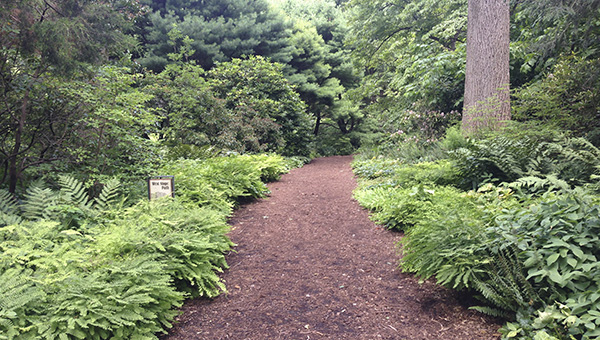Arboretum Paths: Nature’s beauty – inspiration for your garden
Published 7:00 am Wednesday, July 1, 2015

Like Crosby Arboretum’s pathways, this woodland walk at the Mt. Cuba Center in Delaware is a designed landscape with an informal, natural appearance .
Photo by Pat Drackett
Last week I had the pleasure of strolling down many beautifully landscaped pathways that led me through equally attractive public gardens and grounds. All of these walkways had one thing in common: they were lined with native plants that reflected their region.
Whether they had been planted, such as the beds surrounding an approach walk to a state park welcome center filled with native grasses, butterfly weed (Asclepias tuberosa), and blazing star (Liatris spicata), or were naturally occurring – as with the rhododendrons that had somehow found a foothold on stony mountainsides alongside towering sugar maple, oaks, American beech and sassafras, these landscapes all shared a natural beauty that appeared to have simply developed effortlessly. The planted landscapes which had the appearance of naturally-occurring ones were the result of a designer who had obviously been acquainted with the patterns of the plants when growing in their native habitats.
Those who reside in Pearl River County are fortunate, as the area is rich in natural beauty. When time has allowed for visits to Arboretum members’ properties, I’ve been awed by the loveliness of gardens that have been cultivated to work with the natural appearance of their native surroundings. Plantings that are purposefully designed to have a carefree, informal appearance blend well with nature, and with the landscape of the region.
One of the first steps for the MSU landscape architecture students in Professor Bob Brzuszek’s class, who helped to design our Gum Pond and Swamp Forest Educational Exhibits, was to visit examples of these locally occurring habitats and to study the patterns of the plants growing there. Even without a childhood spent immersed in nature, it is possible to learn how to observe and replicate its patterns.
An excellent article to get you started with creating a landscape that has a good “fit” with the naturally-occurring plants on your property can be found at the Mississippi State Extension Service website, www.MSUcares.com (enter the keywords “naturalistic landscapes” in the search field on the home page), called “Designing with Native Plants and Naturalistic Landscapes”. The guide will give you a firm foundation for understanding your property, its context within the regional landscape, and the principles of designing a naturalistic garden.
Other landscapes enjoyed last week on my travels included a greenspace familiar to most of us – Central Park in New York City. A walk in the park was truly a welcome respite from the city’s hustle and bustle. Many have also heard of Fredrick Law Olmsted, the person who designed Central Park, often called the “father of landscape architecture”. Olmsted’s intent for his landscape designs was that they would not have the appearance of being designed at all, but instead convey a natural appearance, ultimately concealing the fact that there had been an artist at all. This way, those who experienced these landscapes would become totally immersed in the landscape’s natural beauty.
Other sites visited this past week included the residence designed by architect Frank Lloyd Wright known as Fallingwater, and its breathtakingly beautiful grounds, near Pittsburgh, Pennsylvania, and the Mt. Cuba Center near Wilmington, Delaware, which features native plants of the region. Both of these sites have a connection to the Crosby Arboretum. Personnel from the Mt. Cuba Center gave valuable guidance and insight during the early planning of the Crosby Arboretum, and Frank Lloyd Wright was both teacher and friend to Fay Jones, the architect who designed the Arboretum’s Pinecote Pavilion.
Mark your calendar for the Crosby Arboretum’s annual Aquatic Plant Sale on Saturday, July 11, from 9:00 a.m. to 2 p.m. Admission to the garden will be free that day. Attend the plant sale and enjoy two special programs about aquatic plant species. Pearl River County Master Gardener Eileen Hollander will reveal the secrets of Louisiana iris propagation and culture at 10 a.m. and Marc Pastorek, owner of Pastorek Habitats native landscaping firm, will lead a walk along the Pond Journey, beginning at 11 a.m., which will explore the plants seen in the Aquatic Exhibit.
The Arboretum is open Wednesdays through Sundays from 9 a.m. to 5 p.m. and located in Picayune, off I-59 Exit 4, at 370 Ridge Road (south of Walmart and adjacent to I-59). For more information about our programs and events, see the website atwww.crosbyarboretum.msstate.edu.
FOR FURTHER EXPLORATION: Research the Mt. Cuba Center, Fallingwater, and Fredrick Law Olmsted. Perhaps you’ll be inspired to plan a visit!
By Patricia Drackett





